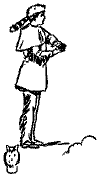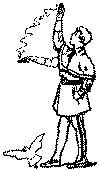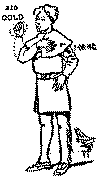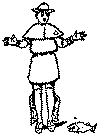By Dan Beard
How to Talk the Real American Indian Sign Language as it was Used in Daniel Boone's Time.
[Note: Be sure to check out William Tomkins' Indian Sign Language Dictionary]
Every American boy knows that holding up two front fingers means "let's go swimming," or, as the case may be, "I am going swimming"; but this is about as far as boy sign language goes, but every Son of Daniel Boone should be acquainted with the American Indian sign language, or at least enough of it to make himself understood by his companions. There are, however, but few white men left in this country who could teach them this language, and they are all elderly men, so it is "up to the boys" to learn now, so that the art may not be forgotten and entirely lost.
I know the boys will learn this language as soon as they have an opportunity, if for no other reason than the fun they can have with it. With the sign language they can exchange confidences right before the grown folks, and the latter will not have the least idea what the boys are talking about.
To begin with, then, we will take that object which attracts the most attention in the daytime.

Fig. 202.
Sun
1. SUN: Hold up the hand with the thumb and first finger together in the form of a circle (Fig. 202).

Fig. 203.
Hot, Heat
2. HEAT: The two hands raised as high as the head and bending forward horizontally with the points of the fingers curving a little downward (Fig. 203).

Figs. 204, 205.
Fire
3. FIRE: The two hands brought near the breast, touching or approaching each other and half-shut, then moved outward with a moderately quick motion, the fingers being extended and the hands a little separated at the same time, to imitate the appearance of flame (Fig. 204).
4. SMOKE: Begin with the sign of fire (Fig. 204), then raise the hand upward with the fingers open (Fig. 205).

Fig. 206.
Night, Darkness
5. NIGHT: Bring the two hands together with the fingers extended across one another as if to shut out the light (Fig. 206).

Fig. 207.
Moon
6. MOON: The thumb and finger open are elevated toward the right ear (Fig. 207); this last sign is generally preceded by No. 5, the sign of night or darkness.

Fig. 208.
Earth
7. EARTH: The two hands open and extended, brought horizontally near each other opposite either knee, then carried to the opposite side and raised in a curve movement until brought around and opposite the face (Fig. 208).

Fig. 209.
Air, Wind.
8. AIR: The right hand held perpendicularly upward and brought forward with a shaking, tremulous or vibratory motion until it passes beyond the face (Fig. 209).

Figs. 210, 211.
I am Cold.
9. COLD: The sign of air may also mean cold, but if you want to say:
10. SOMEBODY COLD: Hold up your right fist opposite the shoulder and shake it as if you were shivering (Fig. 210).
11. "I": If you bring your fingers down and lay them against your breast, that stands for "I."
12. I AM COLD: " I" combined with No. 9 means "I am cold" (Fig. 211).

Fig. 212.
Water.
13. WATER: Group your fingers together so as to form a bowl with your hand, then bring your hand upward as if you were conveying the water to your mouth to drink, but let the hand pass up by the mouth and not stop at it (Fig. 212).

Fig. 213.
Rain.
14. RAIN: Begin with the sign of water, then raise the hands even with the forehead, extending the fingers outward, and give a shaking motion, to represent the dripping of water (Fig. 213).

Figs.
214-216.
15. EGG: Hold the hand with the back down and the fingers brought together, as if they were holding an egg (Fig. 214).
16. STONE or HARDNESS: Beat the palm of your left hand with your right fist (Fig. 215).
17. WHITE: Open the left hand and with the fingers of the right hand rub the place between the thumb and first finger (Fig. 20).
18. HAIL and SLEET: First make the sign of rain (Figs. 212 and 213), next give the sign of cold (Fig. 210), then give the sign of hardness (Fig. 215), and, lastly, give the sign of the egg (Fig. 214.). What you have now said is: That it was, or is, raining; that it was, or is, cold; that the rain is hard like a stone and shaped like an egg; in other words, that it is hail and rain. Thus, you see, by combining these signs, you can convey almost any idea.
19. SNOW: Begin with the sign of rain (Fig. 213), then make the sign of air or cold (Fig. 209 or 210), and conclude with the sign of white (Fig. 216).
20. ICE: Begin with the sign of water (Fig. 212), then of cold (Fig. 210), then the earth (Fig. 208), and, lastly, a stone (Fig. 215).
21. SPRING SEASON: The sign of cold (Fig. 210 or 209), to which add the sign of being done or finished. (See last paragraph of this chapter.)
22. FROST: Begin with the sign of water (Fig. 212), then the sign of night (Fig. 206) or darkness, then the sign of cold (Fig. 210), then the sign of white (Fig. 216), and, lastly, the earth (Fig. 208).

Fig. 217.
Clear.
23 CLEAR: The hands are spread, uplifted and extended both ways from the head (Fig. 217).
24. THUNDER: The sign of rain (Fig. 213) accompanied by the voice imitating the rumbling noise of thunder.
25. LIGHTNING: First give the sign of thunder, then separate the hands, and, lastly, bring the right hand down toward the earth right in front of you.

Fig. 218.
Cloud.
26. CLOUD: Begin with the sign of water (Fig. 212), then raise the two hands as high as the forehead, and, placing them with a slight inclination, let them gently cross one another (Fig. 218).

Fig. 219.
Big, Large, Great.
27. BIG, GREAT, or LARGE: The two hands placed wide apart on each side of the body, and moved forward (Fig. 219).

Fig. 220.
Fear, Fearful.
28. FEAR, TO BE AFRAID, TO CAUSE FEAR: The two hands with the fingers turned inward opposite to the lower ribs, then brought upward with a tremulous movement, as if to represent the common idea of the heart rising up into the throat (Fig. 220).
29. TORNADO: First make the sign of air (Fig. 209), then of large or great (Fig. 219), and then the sign of fear (Fig. 220).

Fig. 221.
Many.
30. MANY or MUCH: The flat of the right hand patting on the back of the left hand, which is repeated in proportion to the greater or lesser quantity (Fig. 221).

Fig. 222.
Man.
31. MAN: With the forefinger of the right hand extended and the hand shut, describe a line beginning at the pit of the stomach and passing down the middle of the body as far as the hand conveniently reaches, holding the hand there a moment (Fig. 222).

Fig. 223.
Woman.
32. MALE or FEMALE: To distinguish between the male and the female, in all cases add for the male a fillip with the forefinger of the right hand on the cheek and for a woman bring the two hands open toward the breast, the fingers approaching, and then move them outward (Fig. 223).
33. BOY: Bring the fingers and thumb of the right hand to touch the lips, then make the sign of a man (Fig. 222.), and then raise the hand with the fingers upward and placed at the height of a boy.
34. GIRL: Begin with the sign of a boy and make the sign of a woman, and then raise the hand to the height of a girl.
35. BABY: Place the fingers and thumb of the right hand against the lips, then draw them away and bring the right hand against the forearm of the left, as if holding an infant. Should the child be male, fillip your cheek before the last sign, and if a female, give the sign of a woman.
36. BODY: The hands with the fingers pointed to the lower part of the body and then drawn upward.
37. HAIR: The movement of combing.
38. YOU: The band open, held upward slantingly and pointing forward.
39. WHAT DID YOU SAY?: Make a gesture with the palm of the hand upward and carried circularly outward and depressed.
40. HE or ANOTHER: The forefingers extended and the hand shut, the forefingers brought over one another, or nearly touching, and then separated moderately quick.
41. GO: The back of the hand stretched out and upward.
42. COME: Forefinger moved from right to left with an interrupted motion, as if imitating the alternate movement of stepping.
43. COME HERE: The hand stretched outward with the palm under, and brought back with a curve motion downward and inclining to the body.
44. MINE: Hand shut and held up to view, as if you had something in it.
45. KNOW: The forefinger of the right hand held up nearly opposite the nose, and brought with a half-turn to the right and carried a little outward. Place any of the articles before the last sign, which will then signify, I know, he knows, you know. Both hands being made use of in the manner described, implies to know much.
46. NOW or AT PRESENT: The two hands forming each a hollow and brought near each other and put into a tremulous motion upward and downward.
47. WHAT SAY YOU?: Make the same gesture given in No. 39.
48. NO, NOTHING, I HAVE NONE: The hand held up before the face, with the palm outward, and vibrated to and fro.
49. FROM WHENCE COME YOU, SAY: First the sign of you, then the hand extended open and drawn to the breast, and, lastly, the sign of " What say you "
50. HOUSE, TEPEE, TENT: The hand open and the forefinger extended and separated, then, raising the hand upward, give it a half-turn as if twisting something.
51. HORSE: The right hand with the edge downward, the fingers joined, the thumb resting on hand, extended forward.
52. MAN ON HORSEBACK: Make sign of man and sign of horse, then put your first two fingers of the right hand over left hand, like the legs of a man riding astride of a horse.
53. DEER: The right hand extended upward by the right ear, with a quick puff from the mouth.
54. BOW: The left being a little extended, the right hand touches it and makes the motion of drawing the string of the bow.
55. GUN: Make a motion like taking aim with a gun.

Fig. 224.
The Same, Alike.
56. ALIKE, SAME, or SIMILAR: to what went before. Place the two forefingers parallel to each other and push them forward a little (Fig. 224).
57. BRING, FETCH, or GIVE ME: The hand half-shut, with the thumb pressing against the forefinger, being first moderately extended either to the right or to the left, is brought with a moderate jerk to the opposite side, as if something was pulled along by the hand.
58. GIVE ME WATER: The sign of water before the . preceding sign.
59. COW or BUFFALO: The two forefingers brought up to the side of the head and extended outward so as to represent the position of the horns.
60. PHEASANT, GROUSE, or BARN-YARD FOWL: Bring the thumb and fingers of the right hand together and, holding the hand moderately elevated, move them in front of you, imitating the motion of the head of a cock in walking.
61. BIRD: The open hands brought up opposite the shoulders and imitating the motions of the wings of a bird.
62. TURKEY: Make the sign of a bird, then of a barnyard fowl.
63. SWIMMING: Extend the forefinger of the right hand outward and move it to and fro.
64. DUCK: The sign of the turkey, then the sign of water, and, lastly, the sign of swimming; that is, a bird that swims.
65. DONE: The hands placed edge up and down, parallel to each other, the right hand without, which latter is drawn back as if cutting something means Done or Finished.